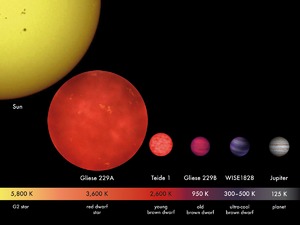Astronomy:Teide 1
 Estimated relative size of the planet Jupiter and the brown dwarfs WISE 1828+2650, Gliese 229B, and Teide 1 compared to the Sun and a red dwarf. Credit: MPIA/V. Joergens. | |
| Observation data Equinox J2000.0]] (ICRS) | |
|---|---|
| Constellation | Taurus |
| Right ascension | 03h 47m 17.915s[1] |
| Declination | +24° 22′ 31.75″[1] |
| Characteristics | |
| Spectral type | M8[2] |
| Apparent magnitude (J) | 16.215[3] |
| Apparent magnitude (H) | 15.591[3] |
| Apparent magnitude (K) | 15.096[3] |
| Astrometry | |
| Proper motion (μ) | RA: 21.681±2.695[1] mas/yr Dec.: −43.254±1.485[1] mas/yr |
| Parallax (π) | 7.5777 ± 1.7015[1] mas |
| Distance | approx. 430 ly (approx. 130 pc) |
| Details | |
| Mass | 55 ± 15[4] MJup |
| Luminosity | 0.0008–0.0005[5] L☉ |
| Temperature | 2,584 ± 150[4] K |
| Age | 0.105 ± 0.035[5] Gyr |
| Other designations | |
| Database references | |
| SIMBAD | data |
Teide 1 is a brown dwarf located ~430 light years away. It was the first brown dwarf to be verified, in 1995.[6] Its surface temperature is 2,600 ± 150 K,[4] which is about half that of the Sun. Its luminosity is 0.08–0.05% of that of the Sun.[5] It is located in the Pleiades cluster, approximately 400 light-years (120 pc) from Earth, and is estimated to have about the same age as it, giving a plausible range from 70 to 140 Myr.[5]
Discovery
Teide 1 was detected by Rafael Rebolo López, María R. Zapatero-Osorio and Eduardo L. Martín in optical images obtained in January 1994 with the 0.80 meter diameter telescope (IAC-80) from the Instituto de Astrofísica de Canarias, located at the Teide Observatory on the island of Tenerife. Its cold nature was confirmed in December 1994 with the William Herschel telescope (WHT) of the Roque de los Muchachos observatory in La Palma. On May 22, 1995, the article reporting their discovery was submitted to the journal Nature, which published it on September 14, 1995. Meanwhile, a similar object, Calar 3, was discovered. The brown dwarf nature of Teide 1 and Calar 3 was confirmed in 1996 following spectroscopic observations with the 10-meter diameter telescope of the W. M. Keck observatory of Mauna Kea on the island of Hawaii.
Gallery
Teide 1 in the Pleiades as seen by the Spitzer Space Telescope
References
- ↑ 1.0 1.1 1.2 1.3 Vallenari, A. et al. (2022). "Gaia Data Release 3. Summary of the content and survey properties". Astronomy & Astrophysics. doi:10.1051/0004-6361/202243940 Gaia DR3 record for this source at VizieR.
- ↑ 2.0 2.1 "2MASS J03471792+2422317". SIMBAD. Centre de données astronomiques de Strasbourg. http://simbad.u-strasbg.fr/simbad/sim-basic?Ident=2MASS+J03471792%2B2422317.
- ↑ 3.0 3.1 3.2 Cutri, Roc M.; Skrutskie, Michael F.; Van Dyk, Schuyler D.; Beichman, Charles A.; Carpenter, John M.; Chester, Thomas; Cambresy, Laurent; Evans, Tracey E. et al. (2003). "VizieR Online Data Catalog: 2MASS All-Sky Catalog of Point Sources (Cutri+ 2003)". CDS/ADC Collection of Electronic Catalogues 2246: II/246. Bibcode: 2003yCat.2246....0C. http://vizier.u-strasbg.fr/viz-bin/VizieR?-source=II/246.
- ↑ 4.0 4.1 4.2 Mid-IR Observations of the Pleiades Brown Dwarfs Teide 1 & Calar 3 (Leech 2000)
- ↑ 5.0 5.1 5.2 5.3 R. Rebolo; E. L. Martín; G. Basri; G. W. Marcy; M. R. Zapatero-Osorio (1996). "Brown Dwarfs in the Pleiades Cluster Confirmed by the Lithium Test". The Astrophysical Journal 469: 53–56. doi:10.1086/310263. Bibcode: 1996ApJ...469L..53R.
- ↑ Rebolo, Rafael (2014), "Teide 1 and the Discovery of Brown Dwarfs", in Joergens, Viki, 50 Years of Brown Dwarfs – From Prediction to Discovery to Forefront of Research, Astrophysics and Space Science Library, 401, Springer, pp. 25–50, doi:10.1007/978-3-319-01162-2_4, ISBN 978-3-319-01162-2, https://www.springer.com/astronomy/book/978-3-319-01161-5
External links
- Walter Myers (1995). "Teide 1". Archived from the original on 2009-05-02. https://web.archive.org/web/20090502144637/http://www.arcadiastreet.com/cgvistas/dwarfs_010.htm.
- http://www.astro-tom.com/technical_data/magnitude_scale.htm
 |


